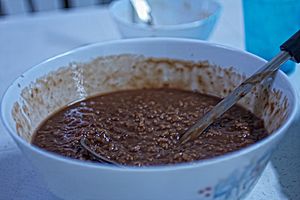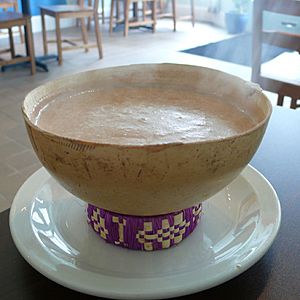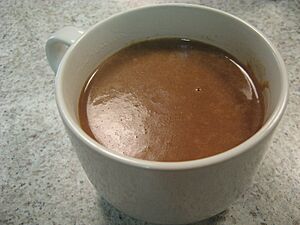Champurrado facts for kids
Champurrado is a yummy, warm, and thick chocolate drink from Mexico. It's a special type of drink called atole. People make it with a dough from corn called masa, or corn flour. Other ingredients often include a type of brown sugar called piloncillo, water or milk, and yummy spices like cinnamon or vanilla. Sometimes, people add nuts or orange peel to make it even richer!
To make it frothy, people use a special wooden whisk called a molinillo. They roll the whisk between their hands to make lots of bubbles. You can also use a blender!
Champurrado is often enjoyed with churros (a fried pastry) for breakfast or as an afternoon treat. It's super popular during Mexican holidays like Day of the Dead and Las Posadas (around Christmas time). It's often served with delicious tamales.
Contents
History of Champurrado
Chocolate comes from Mexico! Ancient civilizations like the Mayas and the Aztecs were the first to grow cocoa beans. The Mayas even used cocoa beans in special ceremonies.
The Aztecs drank chocolate mixed with corn dough, or masa, as far back as 450 BC. They believed these drinks were magical. They thought drinking them would give them power and strength!
In the 1500s, explorers from Spain visited the Americas many times. They brought chocolate back to Spain. At first, only very rich people could afford this special drink. It was a luxury!
Over time, the drink changed. Early Spanish settlers in Mexico learned about the Aztec corn and chocolate drink. They added new ingredients like sugar, milk, and more chocolate to make it sweeter and creamier.
Sugarcane, which makes sugar, came to the Americas after the Europeans arrived. Before that, chocolate was often bitter without any added sweetness. The Spanish also created a chilled chocolate drink with vanilla and other spices. This was very different from the sweet, warm hot chocolate we know today.
Champurrado has been a popular Mexican drink since ancient times, long before Europeans arrived.
How Champurrado is Made
Champurrado is a type of atole that has chocolate in it. The main difference between regular hot chocolate and champurrado is that champurrado uses masa harina (corn flour).
To make atole, people toast masa on a hot griddle. Then, they add water that has been boiled with cinnamon sticks. The drink can be thick like a porridge or thinner, depending on how it's made. In some parts of Mexico, they use pinole (sweetened toasted corn meal) instead of masa.
Atole is a traditional drink for Mexican holidays like Day of the Dead and Las Posadas. But people also enjoy it for breakfast or dinner any time of year! You can often find it sold as street food or in Latin restaurants. When you add chocolate to atole, it becomes champurrado!
There are many different ways to make champurrado. Different states in Mexico might add special spices to make it taste even better. For an authentic taste, many people use Mexican chocolate brands like “Abuelita”. You can often find this chocolate in grocery stores. Cooking champurrado in a clay pot is also traditional. It's said to make the flavor even richer!
Ancient Traditions
The traditions behind atole go back thousands of years in ancient Mexico. Studies show that people were making atole in Mexico five to six thousand years ago, much like they do today! Atole is a drink made with masa, which is finely ground corn flour. It only becomes champurrado when chocolate is added.
The word 'Atole' comes from Nahuatl, the language of the Aztecs. The Aztecs drank atole for centuries. It was one of the easiest ways to eat corn, which was first grown in the Americas.
To make this drink in a traditional way, people used a tool called a metate. This is a piece of rough volcanic rock with three legs, used for grinding. People would grind corn by moving another oblong stone back and forth over the metate. This grinding process was usually done by women. They would kneel and use their body weight to grind the corn. It was a slow and tiring job, but it created the masa needed for atole and champurrado!
Champurrado Around the World

The invention of champurrado shows how ancient practices mixed with new ideas from European settlers. Special tools like the molinillo were created to help make the drink. This tool is now also used to make traditional hot chocolate in many places that were once Spanish colonies.
There are many versions of champurrado in different countries. For example, in the Philippines, there's a unique version called champorado. This was inspired by Mexican champurrado, brought over by old trading ships called Manila galleons. But Filipino champorado is different! It uses whole grains of glutinous rice instead of masa. It's a sweet rice porridge, not a drink. People in the Philippines traditionally eat it during cold, rainy days and around the Christmas season.
Many Latin Americans, especially Mexicans, love to enjoy a warm cup of champurrado during the holidays when the weather gets colder. Many people say champurrado is a delicious drink that tastes very different from regular hot chocolate because of its unique texture and flavor. The taste can also change depending on how it's made and what spices are used.
See also
 In Spanish: Champurrado para niños
In Spanish: Champurrado para niños



